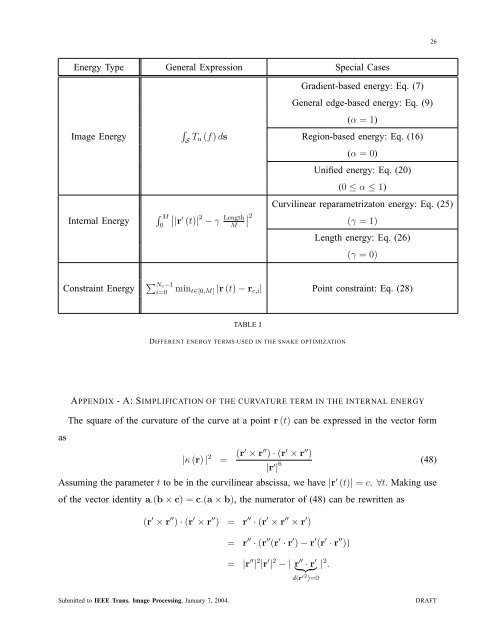Efficient energies and algorithms for parametric snakes - EPFL
Efficient energies and algorithms for parametric snakes - EPFL
Efficient energies and algorithms for parametric snakes - EPFL
You also want an ePaper? Increase the reach of your titles
YUMPU automatically turns print PDFs into web optimized ePapers that Google loves.
26Energy Type General Expression Special CasesImage EnergyInternal Energy∫ M0∫Gradient-based energy: Eq. (7)General edge-based energy: Eq. (9)(α = 1)S T u (f) ds Region-based energy: Eq. (16)(α = 0)Unified energy: Eq. (20)(0 ≤ α ≤ 1)Curvilinear reparametrizaton energy: Eq. (25)∣ |r ′ (t)| 2 − γ Length ∣ 2 (γ = 1)MLength energy: Eq. (26)(γ = 0)Constraint Energy∑ Nc−1i=0min t∈[0,M] |r (t) − r c,i | Point constraint: Eq. (28)TABLE IDIFFERENT ENERGY TERMS USED IN THE SNAKE OPTIMIZATIONasAPPENDIX - A: SIMPLIFICATION OF THE CURVATURE TERM IN THE INTERNAL ENERGYThe square of the curvature of the curve at a point r (t) can be expressed in the vector <strong>for</strong>m|κ (r) | 2 = (r′ × r ′′ ) · (r ′ × r ′′ )|r ′ | 6 (48)Assuming the parameter t to be in the curvilinear abscissa, we have |r ′ (t)| = c, ∀t. Making useof the vector identity a.(b × c) = c.(a × b), the numerator of (48) can be rewritten as(r ′ × r ′′ ) · (r ′ × r ′′ ) = r ′′ · (r ′ × r ′′ × r ′ )= r ′′ · (r ′′ (r ′ · r ′ ) − r ′ (r ′ · r ′′ ))= |r ′′ | 2 |r ′ | 2 − | r } ′′ {{ · r }′ | 2 .d(r ′2 )=0Submitted to IEEE Trans. Image Processing, January 7, 2004.DRAFT
















